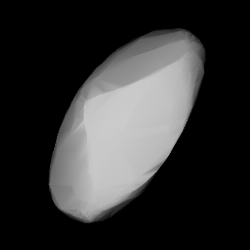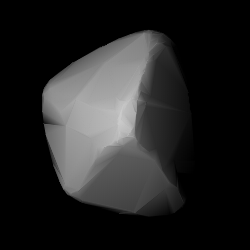2069 Hubble, provisional designation 1955 FT, is a carbonaceous asteroid from the outer region of the asteroid belt, approximately 40 kilometers in diameter. It was discovered on 29 March 1955, by the Indiana Asteroid Program at Goethe Link Observatory, United States, and named after American astronomer Edwin Hubble.
4217 Engelhardt, provisional designation 1988 BO2, is a stony Phocean asteroid and a potentially binary system from the inner regions of the asteroid belt, approximately 9 kilometers in diameter. It was discovered on 24 January 1988, by American astronomer Carolyn Shoemaker at Palomar Observatory in California, and later named after German mineralogist Wolf von Engelhardt.

950 Ahrensa, provisional designation 1921 JP, is a stony Phocaea asteroid and slow rotator from the inner regions of the asteroid belt, approximately 15 kilometers in diameter. It was discovered on 1 April 1921, by German astronomer Karl Reinmuth at Heidelberg Observatory in southern Germany.
1575 Winifred, provisional designation 1950 HH, is a stony Phocaea asteroid and slow rotator from the inner regions of the asteroid belt, approximately 9.5 kilometers in diameter.
2023 Asaph, provisional designation 1952 SA, is a dark asteroid from the outer regions of the asteroid belt, approximately 21 kilometers in diameter. It was discovered on 16 September 1952, by astronomers of the Indiana Asteroid Program at Goethe Link Observatory in Indiana, United States.
1092 Lilium, provisional designation 1924 PN, is a dark, carbonaceous background asteroid from the outer regions of the asteroid belt, approximately 44 kilometers in diameter. It was discovered on 12 January 1924, by German astronomer Karl Reinmuth at the Heidelberg Observatory in southwest Germany. The asteroid was named after the flower Lilium.

1568 Aisleen, provisional designation 1946 QB, is a stony Phocaea asteroid from the inner regions of the asteroid belt, approximately 12.5 kilometers in diameter. It was discovered on 21 August 1946, by South African astronomer Ernest Johnson at Johannesburg Observatory in South Africa. It is named for the discoverer's wife, Aisleen Johnson.

2839 Annette is a bright Flora asteroid from the inner regions of the asteroid belt. It was discovered on 5 October 1929, by American astronomer Clyde Tombaugh at Lowell Observatory during his search for Pluto. The presumed S-type asteroid has a rotation period of 10.5 hours and measures approximately 5 kilometers in diameter. It was named after the discoverer's daughter.
3353 Jarvis, or by its provisional designation, 1981 YC, is a carbonaceous Hungaria asteroid, slow rotator and suspected tumbler from the inner regions of the asteroid belt, approximately 10 kilometers in diameter.
4868 Knushevia, provisional designation 1989 UN2 is a bright Hungaria asteroid and suspected binary system from the innermost regions of the asteroid belt, approximately 2 kilometers in diameter. It was discovered on 27 October 1989, by American astronomer Eleanor Helin at the Palomar Observatory in California, United States. The asteroid was named for the Kyiv University in Ukraine.
6255 Kuma, provisional designation 1994 XT, is a carbonaceous asteroid from the central region of the asteroid belt, approximately 22 kilometers in diameter. It was discovered on 5 December 1994, by Japanese astronomer Akimasa Nakamura at Kuma Kogen Astronomical Observatory on the Island of Shikoku, Japan. It was named after the Japanese town of Kumakōgen.
5430 Luu, provisional designation 1988 JA1, is a stony Phocaea asteroid from the inner regions of the asteroid belt, approximately 7 kilometers in diameter. It was discovered on 12 May 1988, by American astronomer couple Carolyn and Eugene Shoemaker at Palomar Observatory, California, and later named after astronomer Jane Luu.
2696 Magion, provisional designation 1980 HB, is a dark background asteroid and a slow rotator from the inner regions of the asteroid belt, approximately 21 kilometers in diameter. It was discovered on 16 April 1980, by Slovak astronomer Ladislav Brožek at the Kleť Observatory in former Czechoslovakia. The X-type asteroid has an ambiguous rotation period of 480 hours and is possibly a tumbler. It was named for the first Czechoslovak satellite, Magion 1, launched in 1978.
3066 McFadden, provisional designation 1984 EO, is a stony background asteroid from the central regions of the asteroid belt, approximately 15 kilometers in diameter. It was discovered on 1 March 1984, by American astronomer Edward Bowell at the Anderson Mesa Station near Tucson, Arizona. It was named for American planetary scientist Lucy-Ann McFadden. The assumed S-type asteroid has a rotation period of 13.8 hours.
4383 Suruga, provisional designation 1989 XP, is a Vestian asteroid and binary system from the inner regions of the asteroid belt, approximately 6.5 kilometers in diameter. It was discovered on 1 December 1989, by Japanese astronomer Yoshiaki Oshima at Gekko Observatory, Japan. The asteroid was named after the former Japanese Suruga Province. Its synchronous minor-planet moon, S/2013 (4383) 1, measures approximately 1.33 kilometers and has a period of 16.386 hours.

2120 Tyumenia is a dark background asteroid, approximately 45 kilometers in diameter, located in the outer regions of the asteroid belt. It was discovered on 9 September 1967, by Soviet astronomer Tamara Smirnova at the Crimean Astrophysical Observatory in Nauchnyj, on the Crimean peninsula. The asteroid was named for the now Russian district of Tyumen Oblast in Western Siberia.
23712 Willpatrick is a stony Phocaea asteroid from the inner regions of the asteroid belt, approximately 5 kilometers in diameter.
3823 Yorii, provisional designation 1988 EC1, is a carbonaceous asteroid from the outer region of the asteroid belt, approximately 11 kilometers in diameter.
1565 Lemaître, provisional designation 1948 WA, is a highly eccentric Phocaea asteroid and sizable Mars-crosser from the inner regions of the asteroid belt, approximately 8 kilometers in diameter. It was discovered on 25 November 1948, by Belgian astronomer Sylvain Arend at the Royal Observatory of Belgium in Uccle, Belgium. It was named after cosmologist and priest Georges Lemaître.
8026 Johnmckay, provisional designation 1991 JA1, is a binary Hungaria asteroid and very slow rotator from the inner regions of the asteroid belt, approximately 2 kilometers in diameter. It was discovered on 8 May 1991, by American astronomer Eleanor Helin at the U.S. Palomar Observatory, California, and later named for NASA test pilot John B. McKay.




